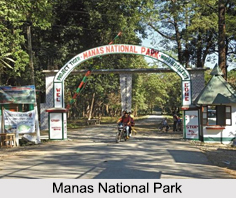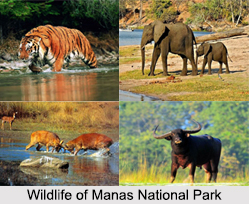 Manas National Park or Manas Wildlife Sanctuary is a UNESCO Natural World Heritage Site, a Project Tiger reserve, an elephant reserve and a biosphere reserve located in Assam. This national park is popular for being the abode of rare and endangered species like Assam roofed turtle, hispid hare, golden langur and pygmy hog. It is also famous for having high population of wild water buffalo. The name of the park has been derived from the Manas River, which was named after the serpent Goddess Manasa.
Manas National Park or Manas Wildlife Sanctuary is a UNESCO Natural World Heritage Site, a Project Tiger reserve, an elephant reserve and a biosphere reserve located in Assam. This national park is popular for being the abode of rare and endangered species like Assam roofed turtle, hispid hare, golden langur and pygmy hog. It is also famous for having high population of wild water buffalo. The name of the park has been derived from the Manas River, which was named after the serpent Goddess Manasa.
History of Manas National Park
Manas National Park was declared a sanctuary on 1st October 1928 and a bio-reserve in 1973. Prior to the declaration it was a reserved forest named Manas R.F. and north Kamrup R.F. Then it was used by the Cooch Behar royal family and Raja of Gauripur as a hunting reserve. Later, Kahitama R.F. the Kokilabari R.F. and the Panbari R.F. were added to the area to form the Manas National Park in the year 1990. In the year 1992, it was declared a World Heritage Site in Danger by UNESCO because of the heavy poaching. But on 21st June 2011, it was removed from that list and initiative was taken for its preservation. On 25th February 2008, the area was expanded to 950 sq km.
Flora of Manas National Park
Manas National Park is one of the richest biodiversity areas in the world because of its combination of Sub-Himalayan Bhabar Terai formation with riverine succession leading up to the Himalayan subtropical broadleaf forests. Main vegetation types of this park are Sub-Himalayan Light Alluvial Semi-Evergreen forests in the northern parts; East Himalayan mixed Moist and Dry Deciduous forests; Low Alluvial Savanna Woodland; Assam Valley Semi-Evergreen Alluvial Grasslands which cover almost 50 percent of the park.
Some of the most common species of flora of Manas National Park are Aphanamixis polystachya, Anthocephalus chinensis, Syzygium cumini, Syzygium formosum, Syzygium oblatum, Bauhinia purpurea, Mallotus philippensis and others. The grasslands are Imperata cylindrica, Saccharum naranga, Phragmites karka, Arundo donax, Dillenia pentagyna etc.
 Fauna of Manas National Park
Fauna of Manas National Park
Manas National Park is the home of 55 species of mammals (21 of them are India"s Schedule I mammals and 31 are threatened), 380 species of birds, 50 of reptiles, and three species of amphibians. The species of fauna of Manas National Park include Indian elephants, Indian rhinoceros, gaurs, Asian water buffaloes, barasingha, Indian tigers, Indian leopards, clouded leopards, Asian golden cats, dholes, capped langurs, golden langurs, Assamese macaques, slow loris, hoolock gibbons, smooth-coated otters, sloth bears, barking deers, hog deers, black panthers, sambar deers and chitals.
Manas National Park houses more than 450 species of birds as well. Its highest population of the endangered Bengal florican is rare one. Some other major species of birds, which are found in Manas National Park are hornbills, jungle fowls, bulbuls, brahminy ducks, kalij pheasants, egrets, pelicans, fishing eagles, crested serpent-eagles, falcons, scarlet minivets, bee-eaters, magpie robins, pied hornbills, grey hornbills, mergansers, harriers, Indian Peafowl, ospreys and herons.
Visiting Information to Manas National Park
The best time to visit the park is from November to March. Nearest airport is at Guwahati (176 km) and nearest rail head is at Barpeta Road (32 km). The park is located at a distance of 176 km from Guwahati. Manas National Park is also connected to major cities by road through National Highway 27.



















